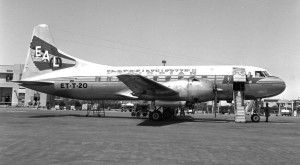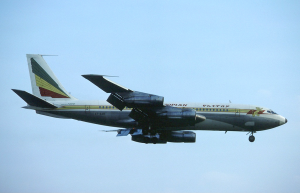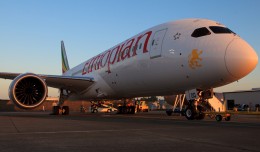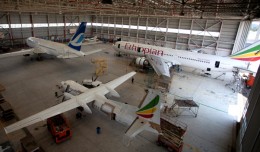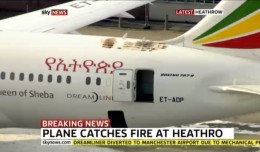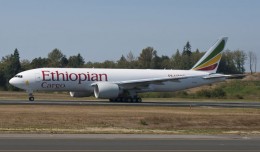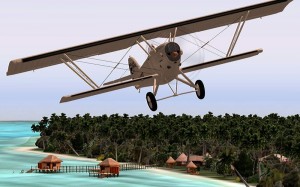 The story of aviation in Ethiopia and its national airline is one of opening up to the world. The landlocked country, bordered by such company as Kenya and Sudan in the Horn of Africa, is known for its harsh and unforgiving terrain. So when a French Potez 25 piloted by Andre Maillet introduced Ethiopia to the airplane on August 18, 1929, it was the beginning of a new age in communication and transportation.
The story of aviation in Ethiopia and its national airline is one of opening up to the world. The landlocked country, bordered by such company as Kenya and Sudan in the Horn of Africa, is known for its harsh and unforgiving terrain. So when a French Potez 25 piloted by Andre Maillet introduced Ethiopia to the airplane on August 18, 1929, it was the beginning of a new age in communication and transportation.
Early Years
The early years of aviation for Ethiopia were marked by Maillet’s contributions and also those of Baron von Engel of Germany. Von Engel, following closely on the heels of Maillet, made the first airmail delivery to the country about three weeks later with a Junkers. Both men made their services available to the government ferrying money, mail and men from the capitol of Addis Ababa to the surrounding provinces.
When foreigners jumpstarted aviation in Ethiopia it was not long in coming that the first two Ethiopian pilots, Mishka Babicheff and Asfaw Ali, earned their wings. Receiving training both in France and on-site in Ethiopia, the pool of indigenous pilots slowly began to grow.
By 1935 the country’s available fleet had expanded fourfold to include 15 aircraft of several types, in addition to a growing aviation infrastructure system across the nation. A total of eight airfields with varying degrees of support services dotted the map within five years of that first visit in 1929.
War
Just as aviation in Ethiopia was beginning to pick up steam in the mid-1930s, the dark shroud of World War II began to fall. The Italians attacked Ethiopia in 1935. Armed with significantly superior equipment that easily dominated the skies, the Italians conquered the country by the end of 1936. Needless to say, there wasn’t much left of the Ethiopian aviation scene by the time all was said and done.
For as much devastation as the Italians wrought during the conflict, their conquests also brought about the first regularly scheduled civilian passenger service. Ala Littoria connected Addis Ababa to Rome as part of the new Imperial Route, which was over three days long. The airline also developed an internal circuit through the country, making stops at 13 locations.
The Italian occupation was short-lived, however, with the British liberating Ethiopia in 1941. Once again, the ravages of war left the aviation community in ruins. The British sequestered whatever remained; citing the ongoing war effort. During the remainder of World War II RAF aircraft provided mail and limited transport services. Resumption of civilian air service, somewhat a misnomer as special clearance was required from the British Embassy, began when BOAC initiated a fortnightly service from Addis Ababa to Cairo via Khartoum utilizing Lockheed Lodestars.
The conclusion of World War II saw the birth of the Ethiopian Air Force. A tiny affair at first, it was composed of a few Cessnas and Tigermoths. Later, via help from the Swedes, Saab Safirs and B17 bombers were acquired. Predictably, many of the pilots and mechanics of the soon-in-coming Ethiopian Air Lines would start their careers in the air force.
The American Connection
The conclusion of World War II ushered in the opportunity to finally establish a national civilian airline. The Ethiopian emperor, hearing that the Americans were flush with cash and material resources, dispatched a delegation to the founding conference of the United Nations to seek assistance from the United States. The US state department arranged a meeting with T. B. Wilson—then chairman of the now-defunct Trans World Airlines (TWA)—who agreed to assist provided that the airline came up with the money. At the time Wilson believed Addis could become an important hub in the region. Curiously, parallel but ultimately unproductive negotiations were also underway with Swedish carrier ABA.
In an arrangement sealed in September of 1945, TWA agreed to provide technical management and operation services while business management was provided by a board of directors split between the Ethiopian government and TWA officials. The official charter, signed several months later in December, marked the beginning of Ethiopian Air Lines (EAL). Besides providing for air services, the charter also gave EAL the power to issue airworthiness certificates to Ethiopian-registered aircraft and to certify competence of ground personnel.
No airline, of course, can truly get off the ground before owning airplanes. The nearest source of readily available and relatively cheap aircraft was Cairo, thanks to the large number of US military surplus left in the city. EAL’s general manager, H. M. “Dutch” Holloway, trekked up to Cairo, where the airline purchased five C-47 aircraft (DC-3s) and recruited five American pilots.
Flights began in early 1946, though they were primarily cargo charters. In order to convince an often skeptical public, the airline initially offered scenic flights over Addis, taking folks into the wild blue yonder to see their houses from the air. Regularly scheduled passenger service began to filter in around the same time, starting with domestic routes. The first international service began in April to Cairo. A trip that previously had taken two days via BOAC and weeks via land now took a mere 10 hours.
At least initially, the trip was still a bit of a chore by today’s standards. Passenger comfort aboard the DC-3 consisted of nothing more than an inward-facing bucket seat along either side of the airplane. Cargo was stored in the middle and could consist of anything from coffee and honey to less pleasant items such as hides or corpses. Seeing the need to compete on international routes, the airline eventually had several of the DC-3s outfitted more appropriately to “luxury class” in the fall of 1946. Surprisingly, DC-3s managed to run international routes as far away as Bombay, India, though its days were numbered on that front.
While the venerable DC-3 would remain in domestic-route and cargo service to EAL for some forty-odd years, the airplane quickly became outdated for international service. Ethiopian thus picked up three Convair 240s in 1950. The new airplanes were an improvement over the DC-3, at least in that they were pressurized. However, runways had yet to match the needs of the larger airplane. Before infrastructure could be upgraded, JATO bottles were attached to the aircraft to help it become airborne. They continued to be used until a misaligned canister blew a hole into an airframe on takeoff. Thankfully, the aircraft recovered without further incident and without injury to those aboard. Needless to say it was the last hurrah for the JATO practice.
Despite the new aircraft, EAL faced stiff competition both politically and economically, which impeded the airline’s expansion. Near-international cities such as Khartoum and Nairobi were both located within British colonies. None too keen to expand competition in their backyard, British authorities in those places often denied EAL landing rights. When EAL was allowed to land, it was often consigned to utilizing less threatening, secondary airfields that were often miles away from the destination.
On the economic front, the airline began to face increasing competition from other airlines with superior aircraft. EAL quickly transitioned from the Convair to the significantly larger DC-6B Cloudmaster in 1956 (the fleet briefly listed a Super Constellation, but it was written off in a fire). While the larger and luxurious DC-6B boosted efficiency and enabled opening new markets such as Frankfurt, Germany, via Athens and Robertsfield, Liberia, via Khartoum and Accra, it was not enough to stop EAL from a downward financial trend.
The late 50’s also saw the introduction of a dedicated maintenance base in Addis. The facility was initially used to reduce the reliance on overseas maintenance for the airline. Increasingly however the airline would come to rely on the base to provide much needed maintenance service for other airlines in the region. Consequently the facility became an increasing part of revenue.
As the 1960s began, with jet service on international routes increasingly becoming an expectation rather than exception, EAL began to consider purchasing a few of its own. Faced with choosing between the SE-210 Caravelle, Comet 4, and the Boeing 720-B, EAL eventually went with the Boeing. A contract for two airplanes was signed with the Seattle aircraft manufacturer in August of 1960, with delivery set for late 1961.
Unfortunately, however, delivery had to be delayed until 1962. The present airfield in Addis, already questionably sufficient for aircraft such as the DC-6B, was absolutely out of the question for the much larger and heavier Boeing jet. As a result the government commissioned a new airfield, located in the Bole neighborhood of Addis, to be built. Despite being approved in 1957, the airport was barely operational when the first jet landed on December 3, 1962.
The B720 began its service with EAL by flying to Nairobi, later opening up a new route to Madrid in January of 1963. A third jet was added to the fleet in 1964, and with it came service to Rome. Two of the original three 707s wound up being wet-leased to the former Lebanese International Airlines (later MEA); one of which crashed due to storms outside Beirut. Additional 707s were purchased from Boeing in 1967 and 1968 (707-360Cs). The airplanes were initially utilized primarily for cargo due to their capacity to haul four times as much as the DC-6. At around the same time the carrier sold off the Convairs, while picking up six additional DC-3s.
Expansion of the route network increased further with the introduction of four flights a week to Paris in 1971 and to London Heathrow in 1973. Perhaps more noteworthy, Ethiopian was able to secure highly coveted service to previously recluse China. Service began to Shanghai in February of 1972 and later that same year migrated to the capitol, Beijing.
The early jet age for EAL (renamed Ethiopian Airlines in 1965) also brought with it a darker side. Realizing the potential for exposure and profit in air travel, political activists and criminals began the habit of bombing and hijacking airplanes. Ethiopian was no exception. Bombings in Frankfurt and Karachi on the ground damaged aircraft, and the airline faced several hijackings—some successful—all in the course of one year. The airline would later face a devastating hijack attempt in the 1990s that ended in tragedy off the African coast.
As the airline entered the 1970s, the fleet of jets continued to expand. The carrier purchased two 720-024Bs from the former Continental Airlines (now United) with an option to take up to six more. Efforts to expand the mid-range fleet and replace aging B720s were met by the venerable Boeing 727, the first of which was delivered in 1979.
Route expansion continued to grow with weekly service to Kigale (Rwanda) and Kinshasha (DRC) in 1975. A Kilimanjaro route began in 1977, and service to the Gulf region began in 1976 via Abu Dhabi and Bahrain, with Bahrain switching to Dubai in 1979.
Turmoil
While the decade of the ’70s marked notable progress, it was also a time of turmoil for Ethiopia and its airline. In 1974 a military junta known as the Derg began wresting control from the government, eventually succeeding later that year. Beginning in the mid-1970s and continuing through the ’80s, Ethiopia became infamous worldwide for severe drought and famine of epic proportion, with accusations that policies of the Derg were intentionally exacerbating the situation. The country spiraled into civil war for nearly sixteen years as various rebel factions attempted to oust the Derg or break away altogether.
Needless to say, such a situation does not lend itself favorably to tourism, one of the mainstays of the international airline’s success. As if civil war weren’t enough, the government drastically cut back on official international travel and also severely limited tourism. This facet was particularly harmful as it cut revenue out of the generally profitable international routes and cargo, which had been subsidizing less-profitable domestic routes. Additional factors included increased landing fees at home, rising fuel prices due to the energy crisis, several labor revolts resulting in costlier concessions from management, and greater competition from other airlines.
As a result, the airline was forced to raise fares while also trimming service and routes across the board. Domestic operations took the brunt of the hit, resulting in four station closures in one month alone. In a bid to stay solvent, the airline also wet-leased airplanes to several carriers including Saudi, Air India, and Air Algerie. Despite a brief resurgence in solvency in the late 1970s—almost entirely thanks to government contracts—the carrier plugged into enormous successive losses to close out the decade. As 1980 rolled around, the financial situation of the carrier was marked most notably by fuel suppliers threatening to take cash only.
Recovery
Despite the rest of the nation falling apart around it, the ’80s marked a transition back toward profitability and a rebuilt reputation, at least by the airline’s own account. Beginning early in the decade, a new general manager, Cpt. Mohammed Ahmed, began to lift the carrier out of crisis. Major reforms began in earnest, starting with the firing and rehiring of most of the staff.
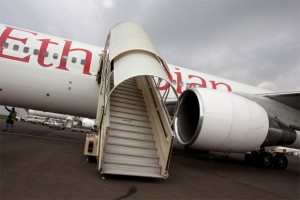 The financial hemorrhage of the mid-to-late ’70s gave way to profitability once again in the early ’80s, even if due in large part to cash injections from the Ethiopian government. The airline responded by investing in ATR-42s and DC-6-300 Otters to replace the severely aging DC-3 fleet. And the carrier ordered the brand-new Boeing 767 as its flagship.
The financial hemorrhage of the mid-to-late ’70s gave way to profitability once again in the early ’80s, even if due in large part to cash injections from the Ethiopian government. The airline responded by investing in ATR-42s and DC-6-300 Otters to replace the severely aging DC-3 fleet. And the carrier ordered the brand-new Boeing 767 as its flagship.
The first Boeing 767-200 arrived on June 1, 1984, setting a non-stop, twin-engine distance record in the process. The airline took delivery of a second later that year and eventually added another two by the year 2000. Expansion, due in large part to the new widebody, saw fresh routes to Harare, Dakar, and Moscow. The sister of the 767, the Boeing 757, was introduced to the fleet in 1990. Fokker 50s were added to compliment the domestic fleet in 1996.
The carrier began service to the Americas in 1998 with New York and Washington Dulles via Rome, though New York was later dropped. Service expanded the following year to Copenhagen and Maputo.
Meanwhile, the dedicated cargo fleet saw the addition of another 727 in ’81 and two Dash-5 Buffalos. Despite the expansion, it was not until 1989 that cargo operations became their own division. According to the airline, cargo had been previously viewed as a public obligation and service rather than an income generator.
In one of only a handful of tragedies in the history of the airline, flight 961, serviced by a Boeing 767-200ER, was hijacked in 1996. Having run out of fuel, the airplane crash-landed off the Comoros Islands. Vacationing tourists caught the landing on tape (which was played around the world) and assisted in rescuing passengers from the water. Sadly, 125 of the 175 on board did not survive. Prior to 9/11 it was the deadliest hijacking in aviation history and remains the worst incident in the history of the airline.
New Millennium
In 2002 the airline embarked on an aggressive expansion and fleet modernization project. The airline picked up another eleven 767s, though this time all -300s, between 2002 and 2012. Four additional 757s were picked up to compliment the existing fleet. The carrier placed a significant order for Boeing 737NGs as well, acquiring -700s at first, while later receiving 737-800s.
Only three years later in 2005, Ethiopian announced its intent to purchase the new and widely touted Boeing 787 Dreamliner, making it the first carrier on the African continent to do so. Perhaps needless to say, that did not go quite as planned, with the airline only receiving its first in Dreamliner mid-2012. The original delivery had been scheduled for 2008.
Perhaps in response to the delays from Boeing, Ethiopian placed its first Airbus order in 2009 for twelve A350 aircraft. Additionally, it is widely believed that delays on the Dreamliner resulted in Ethiopian acquiring—rather suddenly, given their order date in 2009—five Boeing 777-200LRs, which were delivered beginning in late 2010.
Though the 777 was not the intended 787 Dreamliner, it was nonetheless a welcome addition. The long-range widebody enabled direct, non-stop roundtrip service to Beijing and from Washington Dulles (the outbound flight still stops in Rome). The new flagship aircraft certainly put the carrier’s long-haul offerings on par with competing carriers both African and elsewhere. Deliveries of eight Bombardier Q400 turboprop aircraft in 2010 bolstered domestic service, enabling the Fokker 50s to be retired from the fleet by the fall of 2011.
Perhaps sadly, the 777’s time as the flagship of Ethiopian was to be the shortest of any aircraft in the history of the fleet: a mere twenty months. The long-awaited Dreamliner was finally delivered, albeit a bit behind schedule, on August 17, 2012.
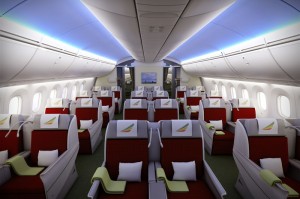 Plans for the Dreamliner abound. The airline has since deployed the aircraft regularly on routes to Toronto, Dubai, and Frankfurt with plans to add Guangzhou and Johannesburg by the end of 2012. The carrier has also not been shy about plans to expand into South America, possibly to Brazil; though any plans involving the Dreamliner have been on hold since the grounding of the type in January 2013.
Plans for the Dreamliner abound. The airline has since deployed the aircraft regularly on routes to Toronto, Dubai, and Frankfurt with plans to add Guangzhou and Johannesburg by the end of 2012. The carrier has also not been shy about plans to expand into South America, possibly to Brazil; though any plans involving the Dreamliner have been on hold since the grounding of the type in January 2013.
But the growth plans do not stop simply at the Dreamliner. As part of its Vision 2025 growth plan, ETH intends to expand the fleet from a current size of roughly 50 aircraft to 120. In addition Ethiopian plans to expand cargo, catering, and maintenance services.
Looking back to its first days in 1946, it would be hard to imagine Ethiopian becoming the African aviation powerhouse it is today. Yet nevertheless the airline managed to continue to grow through obstacles small and large over the years, resulting in the modern fresh carrier we see today.




